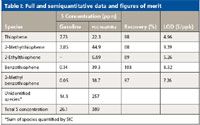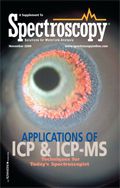Using GC–ICP-MS for Speciation of Sulfur in Reformulated Fuels
Special Issues
GC-ICP-MS for the analysis of gasoline and petroleum
Reduced sulfur emission standards now enforce low sulfur fuels in the European Union and North Amercia and require oil refineries to produce low sulfur diesel fuels. Gas chromatography–inductively coupled plasma mass spectrometry (GC–ICP-MS) is a sensitive, compound-specific technique that allows for quantification of sulfur species at the part-per-billion level in fuels. The information that GC–ICP-MS provides can help the industry understand sulfur chemistry and develop and improve sulfur remediation strategies, and thus, comply with reduced sulfur fuel regulations.
Fuel combustion contributes a significant amount of sulfur to the atmosphere, resulting in ongoing concerns with respect to the concentrations of atmospheric sulfates, sulfuric acid, and the subsequent formation of acidic rain. Elevated atmospheric sulfur concentrations are also known to induce respiratory and cardiovascular illnesses in humans, and there are significant risks associated with long-term human exposure to sulfur pollution in the environment.
Reformulated gasoline, a gas blended to burn cleaner, has been long established as a means of reducing smog-forming and toxic emissions. In the U.S., reformulated gasoline is currently used in 17 states as well as in the District of Columbia. Approximately 30% of gasoline sold in the U.S. is reformulated, ensuring that about 75 million people are breathing cleaner air (1).
The U.S. Environmental Protection Agency (U.S. EPA) has introduced a set of regulations to enforce lower total sulfur concentrations in petroleum and diesel fuels with the goal of reducing subsequent sulfur emissions to the atmosphere. Legislation also exists to regulate the quality and use of reformulated fuel.
Regulatory Outlook
In January 2001 and in June 2004, the U.S. EPA finalized the Highway Diesel (2) and Nonroad Diesel (3) rules, respectively, which mandate the use of lower sulfur fuels in diesel engines. The rules impose a total sulfur limit of 15 ppm. The aim is to reduce harmful emissions by 90% or more yielding significant, long-term benefits for public health and the environment. It has been estimated that by 2030, the reductions in sulfur emissions from nonroad diesel engines will annually prevent 12,000 premature deaths, 8900 hospitalizations and one million work days lost (4).
Further to these rules, the U.S. EPA Regulation of Fuels and Fuel Additives (5) prescribes requirements for the control and prohibition of fuels and additives for use in motor vehicles and motor vehicle engines. The regulation enforces 30 ppm maximum sulfur content in gasoline. It also requires that gasoline sold in certain areas be reformulated. This also is mandated by the Clean Air Act, which requires that reformulated gasoline be sold in the nine largest metropolitan areas of the country with the most severe summertime ozone levels (6).
In accordance with legislation, there is now an increasing requirement for the petrochemical industry to realize effective analytical methodologies for sulfur removal in both raw and processed petrochemical samples.
Traditional Analytical Techniques
The petrochemical industry has long recognized the need to monitor and control total sulfur concentrations in petroleum and diesel fuels before supply. The majority of the sulfur content in gasoline results from the incorporation of the fluid catalytically cracked (FCC) naphtha stream. As a result, the production of low-sulfur FCC naphtha can enable the production of fuels with reduced sulfur content. Another issue that the petrochemical industry faces is the contamination of low-sulfur fuel from common pipelines in the distribution system that also distributes high-sulfur fuels such as jet fuel. To ensure compliance with the maximum content levels set by regulations, the desulfurization process must be optimal. Therefore, an analytical technique offering the capability to determine which sulfur species have been effectively removed in the process is needed.
Gas chromatography (GC) coupled with atomic emission detection (AED) and with sulfur chemiluminescence detection (SCD) have been used extensively for the analysis of sulfur species and total sulfur concentrations in various petrochemical fuels. However, the sensitivity of these techniques is considered insufficient for monitoring fuels containing reduced sulfur concentrations. As a consequence, a more sensitive analytical technique is required to satisfy current and future fuel-analysis requirements.
GC coupled with element-specific inductively coupled plasma–mass spectrometry (ICP-MS) offers an alternative elegant analytical solution for sensitive analyses of sulfur species in fuels. ICP-MS is a multielement, multi-isotopic technique and has shown good performance for the direct analysis of trace elements in gasoline (AN 40768).
GC–ICP-MS
Commercial GC–ICP-MS instrumentation has evolved from use in academic research to use in routine and commercial research.
Capabilities of third-generation collision–reaction cell design are exploited within GC–ICP-MS instrumentation and a powerful reactive chemistry approach attenuates the required isobaric and gas-based polyatomic species to achieve interference-free analysis. All carbon-and plasma-based polyatomic interferences are removed, allowing accuracy within 10% and detection limits in the nanogram-per-kilogram range for most elements.
Overall, GC–ICP-MS methodology provides a highly sensitive and selective approach for quantitative sulfur speciation analyses. It offers a complete analytical solution to refineries and the petrochemical industry at large for the characterization and quantification of sulfur species in fuels. The following experiment was developed to demonstrate the use of GC–ICP-MS for the analysis of sulfur species in FCC naphtha and commercially available gasoline samples.
Application Example
A Thermo Scientific TRACE GC Ultra gas chromatograph and a Thermo Scientific AS3000 autosampler were coupled with a Thermo Scientific XSERIES 2 ICP-MS detector via a GC transfer line. The ICP-MS detector was configured with a dual-mode sample introduction system to facilitate simultaneous introduction of both liquid and gaseous samples through the ICP-MS nebulizer–spray chamber arrangement and GC sample introduction systems, respectively. The ICP-MS detector also was initially autotuned and performance-tested using its integral software tools.
The GC–ICP-MS methodology used for this study facilitated quantification of intrinsic sulfur species using external calibration and a species-independent calibration (SIC) technique. Total sulfur concentrations also were inferred from the sum of the intrinsic sulfur species concentrations. GC–ICP-MS analysis was performed during continuous aspiration of an aqueous blank solution through the nebulizer–spray chamber arrangement, maintaining robust wet plasma conditions throughout the analysis.
Ions derived from the processed chromatographic eluent were extracted from the plasma and focused into the collision–reaction cell of the ICP-MS detector. The collision–reaction cell was pressurized with oxygen throughout the analysis and operated under non-kinetic energy discrimination (KED) conditions to promote conversion of sulfur (32 S+ ) to sulfur oxide (m/z 48 SO+ ) species. The m/z 48 SO+ species subsequently were transferred to the quadrupole for detection and quantitation. This analytical approach shifted the 32 S analyte away from common gas-based polyatomic interferences and also converted any m/z 48 Ti+ ions, which would otherwise form an isobaric interference with m/z 48 SO+ , to the m/z 64 TiO+ species to facilitate interference-free analysis.
Optimal Performance
The major sulfur-containing species encountered in fuel were mercaptans, thiophenes, benzothiophenes, sulfides, and disulfides. Standards of thiophene, 2-methylthiophene, 2-ethylthiophene, benzothiophene, and 2-methyl benzothiophene were used to optimize the GC separation methodology and to generate fully quantitative external calibration curves. A noticeable broadening of the thiophene peak in commercial gasoline compared with the standard chromatography probably was due to coelution of benzene (Figure 1).

Figure 1
Wherever possible, sulfur species were identified in the FCC naphtha and gasoline samples using spiking experiments with known standards. However, similar sensitivity responses were observed for each thiophene standard — that is, as calculated from each fully quantitative external calibration curve. This observation is illustrated in Figure 2, which shows a sulfur calibration in the region of 0.1–10 ppm using calibration standards derived from five sulfur species.

Figure 2
GC–ICP-MS facilitated similar calibration sensitivities for different sulfur species because the inductively coupled plasma processed the eluted sulfur species similarly, regardless of the organic or inorganic functionality. This SIC technique can be exploited further to enable semiquantification of uncharacterized sulfur species and, as such, to avoid the necessity for multiple species-specific fully quantitative calibrations.
Table I presents fully quantitative data for the five calibrated sulfur species standards and semiquantitative data for uncharacterized species using SIC. The gasoline and FCC naphtha samples at a concentration of 5 ppm were found to contain total sulfur concentrations of 26 ppm and 389 ppm, respectively. The GC-ICP-MS methodology was validated by calculating the recovery (89–103%) of standards spiked into the diluted FCC naphtha sample. Limits of detection (3σ) for the five thiophene analogues were calculated in the 5–10 ppb range.

Table I: Full and semiquantitative data and figures of merit
Conclusion
Sulfur emissions have been found to pollute the atmosphere and lead to the formation of acidic rain while also causing respiratory, cardiovascular, and other severe illnesses in humans. These toxic emissions are produced by fuel combustion, necessitating the use of cleaner, environment-friendly fuels. Reformulated gasoline is capable of reducing smog-forming and toxic sulfur emissions. Aiming to reduce harmful emissions and ensure the safety of humans and the environment, the U.S. EPA specifies maximum allowable concentrations of sulfur in fuel as well as mandating the use of reformulated fuel.
To comply with the stringent legislation, petrochemical companies need to implement a powerful, dependable analytical method. GC–ICP-MS increasingly is being recognized within the petrochemical industry as the method of choice for highly sensitive and selective analyses of sulfur species in fuels. The technique uses a simple, automated, and interference-free analytical approach that generates accurate results and enables effortless regulatory compliance.
Shona McSheehy is with Thermo Fisher Scientific, Bremen, Germany. She acknowledges W.M. Geiger, Consolidated Sciences, Inc., for the FCC Naphtha sample and valuable input.
References
(1) EPA website, Reformulated Gas, Basic Information, http://epa.gov/otaq/rfg/information.htm.
(2) EPA website, Federal Register / Vol. 66, No. 12 /January 18, 2001/Rules and Regulations, PART 80—REGULATION OF FUELS AND FUEL ADDITIVES, www.epa.gov/otaq/regs/hd2007/frm/frdslreg.pdf.
(3) EPA website, 40 CFR Parts 9, 69, et al., Control of Emissions of Air Pollution, From Nonroad Diesel Engines and Fuel; Final Rule, www.epa.gov/otaq/url-fr/fr29jn04.pdf.
(4) EPA website, Nonroad Diesel Equipment, Clean Air Nonroad Diesel –Tier 4 Final Rule, www.epa.gov/nonroad-diesel/2004fr.htm.
(5) Electronic Code of Federal Regulation website, Title 40: Protection of Environment, PART 80—REGULATION OF FUELS AND FUEL ADDITIVES, http://ecfr.gpoaccess.gov/cgi/t/text/text-idx?c=ecfr;rgn=div5;view=text;node=40%3A16.0.1.1.9;idno=40;sid=e9b47ca0afa90e604adec25e65fcac88;cc=ecfr#40:16.0.1.1.9.4.47.2.
(6) EPA website, Federal Register Environmental Documents, Regulation of Fuels and Fuel Additives: Standards for Reformulated and Conventional Gasoline, www.epa.gov/EPA-AIR/1996/November/Day-13/pr-23839DIR/Other/fuel.txt.html.

LIBS Illuminates the Hidden Health Risks of Indoor Welding and Soldering
April 23rd 2025A new dual-spectroscopy approach reveals real-time pollution threats in indoor workspaces. Chinese researchers have pioneered the use of laser-induced breakdown spectroscopy (LIBS) and aerosol mass spectrometry to uncover and monitor harmful heavy metal and dust emissions from soldering and welding in real-time. These complementary tools offer a fast, accurate means to evaluate air quality threats in industrial and indoor environments—where people spend most of their time.
NIR Spectroscopy Explored as Sustainable Approach to Detecting Bovine Mastitis
April 23rd 2025A new study published in Applied Food Research demonstrates that near-infrared spectroscopy (NIRS) can effectively detect subclinical bovine mastitis in milk, offering a fast, non-invasive method to guide targeted antibiotic treatment and support sustainable dairy practices.
Smarter Sensors, Cleaner Earth Using AI and IoT for Pollution Monitoring
April 22nd 2025A global research team has detailed how smart sensors, artificial intelligence (AI), machine learning, and Internet of Things (IoT) technologies are transforming the detection and management of environmental pollutants. Their comprehensive review highlights how spectroscopy and sensor networks are now key tools in real-time pollution tracking.